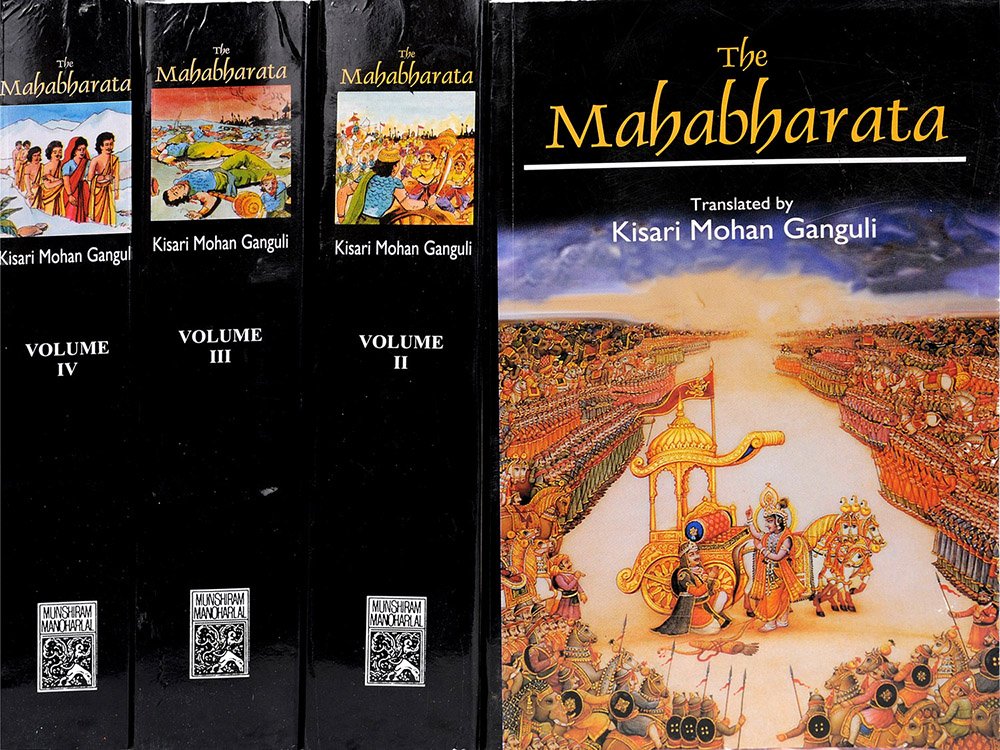Mahabharata (English)
by Kisari Mohan Ganguli | 2,566,952 words | ISBN-10: 8121505933
The English translation of the Mahabharata is a large text describing ancient India. It is authored by Krishna-Dwaipayana Vyasa and contains the records of ancient humans. Also, it documents the fate of the Kauravas and the Pandavas family. Another part of the large contents, deal with many philosophical dialogues such as the goals of life. Book...
Section XLIII
"Vrihannala said,
'That about which you has first enquired is Arjuna’s bow, of world-wide fame, called Gandiva, capable of devastating hostile hosts. Embellished with gold, this Gandiva, the highest and largest of all weapons belonged to Arjuna. Alone equal unto a hundred thousand weapons, and always capable of extending the confines of kingdoms, it is with this that Partha vanquishes in battle both men and celestials.
Worshipped ever by the gods, the Danavas and the Gandharvas and variegated with excellent colours, this large and smooth bow is without a knot or stain anywhere. Shiva held it first for a thousand years. Afterwards Prajapati held it for five hundred and three years. After that Sakra, for five and eighty years. And then Soma held it for five hundred years. And after that Varuna held it for a hundred years. And finally Partha, surnamed Svetavahana,[1] has held it for five and sixty years.[2] Endued with great energy and of high celestial origin, this is the best of all bows.
Adored among gods and men, it has a handsome form. Partha obtained this beautiful bow from Varuna. This other bow of handsome sides and golden handle is Bhima’s with which that son of Pritha, that chastiser of foes, had conquered the whole of the eastern regions. This other excellent bow of beautiful shape, adorned with images of Indragopakas, belongs, O Virata’s son, to king Yudhishthira. This other weapon with golden suns of blazing splendour shedding a dazzling effulgence around, belongs to Nakula. And this bow adorned with golden images of insects and set also with gems and stones, belongs to that son of Madri who is called Sahadeva.
These winged arrows, thousand in number, sharp as razors and destructive as the poison of snakes, belong, O Virata’s son, to Arjuna. When shooting them in battle against foes, these swift arrows blaze forth more brilliantly and become inexhaustible. And these long and thick shafts resembling the lunar crescent in shape, keen-edged and capable of thinning the enemy’s ranks, belong to Bhima. And this quiver bearing five images of tigers, full of yellowish shafts whetted on stone and furnished with golden wings belong to Nakula. This is the quiver of the intelligent son of Madri, with which he had conquered in battle the whole of the western regions.
And these arrows, all effulgent as, the sun, painted all over with various colours, and capable of destroying enemies by thousands are those of Sahadeva. And these short and well-tempered and thick shafts, furnished with long feathers and golden heads, and consisting of three knots, belong to king Yudhishthira. And this sword with blade long and carved with the image of a toad and head shaped as a toad’s mouth, strong and irresistible belongs to Arjuna.
Cased in a sheath of tiger-skin, of long blade, handsome and irresistible, and terrible to adversaries, this sword belongs to Bhimasena. Of excellent blade and cased in a well-painted sheath, and furnished with a golden hilt, this handsome sword belongs to the wise Kaurava—Yudhishthira the just. And this sword of strong blade, irresistible and intended for various excellent modes of fight and cased in a sheath of goat-skin, belongs to Nakula. And this huge scimitar, cased in a sheath of cow-skin, strong and irresistible belongs to Sahadeva.'"
Footnotes and references:
[1]:
From the colour of his steeds.
[2]:
Nilakantha spends much learning and ingenuity in making out that sixty-five years in this connection means thirty-two years of ordinary human computation.
Conclusion:
This concludes Section XLIII of Book 4 (Virata Parva) of the Mahabharata, of which an English translation is presented on this page. This book is famous as one of the Itihasa, similair in content to the eighteen Puranas. Book 4 is one of the eighteen books comprising roughly 100,000 Sanskrit metrical verses.
FAQ (frequently asked questions):
Which keywords occur in Section XLIII of Book 4 of the Mahabharata?
The most relevant definitions are: Arjuna, Partha, Sahadeva, Nakula, Yudhishthira, Bhima; since these occur the most in Book 4, Section XLIII. There are a total of 20 unique keywords found in this section mentioned 36 times.
What is the name of the Parva containing Section XLIII of Book 4?
Section XLIII is part of the Goharana Parva which itself is a sub-section of Book 4 (Virata Parva). The Goharana Parva contains a total of 47 sections while Book 4 contains a total of 4 such Parvas.
Can I buy a print edition of Section XLIII as contained in Book 4?
Yes! The print edition of the Mahabharata contains the English translation of Section XLIII of Book 4 and can be bought on the main page. The author is Kisari Mohan Ganguli and the latest edition (including Section XLIII) is from 2012.
